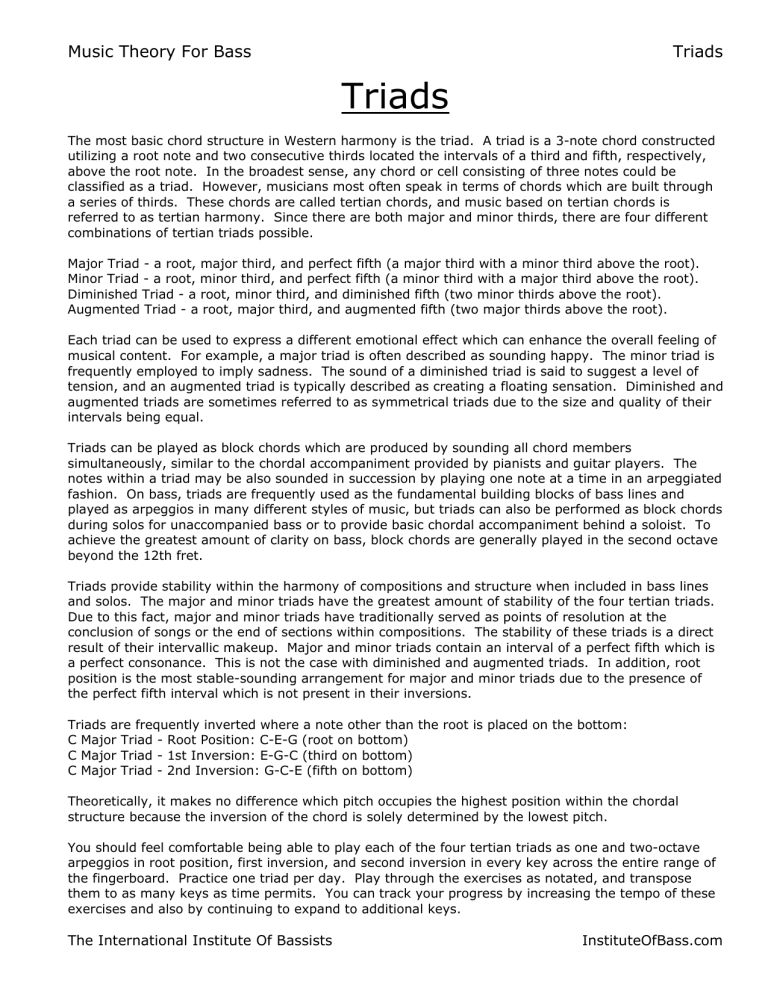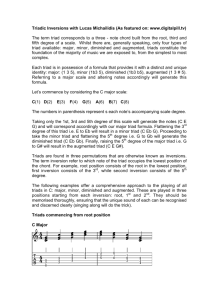Triads - The International Institute Of Bassists

Music Theory For Bass Triads
Triads
The most basic chord structure in Western harmony is the triad. A triad is a 3-note chord constructed utilizing a root note and two consecutive thirds located the intervals of a third and fifth, respectively, above the root note. In the broadest sense, any chord or cell consisting of three notes could be classified as a triad. However, musicians most often speak in terms of chords which are built through a series of thirds. These chords are called tertian chords, and music based on tertian chords is referred to as tertian harmony. Since there are both major and minor thirds, there are four different combinations of tertian triads possible.
Major Triad - a root, major third, and perfect fifth (a major third with a minor third above the root).
Minor Triad - a root, minor third, and perfect fifth (a minor third with a major third above the root).
Diminished Triad - a root, minor third, and diminished fifth (two minor thirds above the root).
Augmented Triad - a root, major third, and augmented fifth (two major thirds above the root).
Each triad can be used to express a different emotional effect which can enhance the overall feeling of musical content. For example, a major triad is often described as sounding happy. The minor triad is frequently employed to imply sadness. The sound of a diminished triad is said to suggest a level of tension, and an augmented triad is typically described as creating a floating sensation. Diminished and augmented triads are sometimes referred to as symmetrical triads due to the size and quality of their intervals being equal.
Triads can be played as block chords which are produced by sounding all chord members simultaneously, similar to the chordal accompaniment provided by pianists and guitar players. The notes within a triad may be also sounded in succession by playing one note at a time in an arpeggiated fashion. On bass, triads are frequently used as the fundamental building blocks of bass lines and played as arpeggios in many different styles of music, but triads can also be performed as block chords during solos for unaccompanied bass or to provide basic chordal accompaniment behind a soloist. To achieve the greatest amount of clarity on bass, block chords are generally played in the second octave beyond the 12th fret.
Triads provide stability within the harmony of compositions and structure when included in bass lines and solos. The major and minor triads have the greatest amount of stability of the four tertian triads.
Due to this fact, major and minor triads have traditionally served as points of resolution at the conclusion of songs or the end of sections within compositions. The stability of these triads is a direct result of their intervallic makeup. Major and minor triads contain an interval of a perfect fifth which is a perfect consonance. This is not the case with diminished and augmented triads. In addition, root position is the most stable-sounding arrangement for major and minor triads due to the presence of the perfect fifth interval which is not present in their inversions.
Triads are frequently inverted where a note other than the root is placed on the bottom:
C Major Triad - Root Position: C-E-G (root on bottom)
C Major Triad - 1st Inversion: E-G-C (third on bottom)
C Major Triad - 2nd Inversion: G-C-E (fifth on bottom)
Theoretically, it makes no difference which pitch occupies the highest position within the chordal structure because the inversion of the chord is solely determined by the lowest pitch.
You should feel comfortable being able to play each of the four tertian triads as one and two-octave arpeggios in root position, first inversion, and second inversion in every key across the entire range of the fingerboard. Practice one triad per day. Play through the exercises as notated, and transpose them to as many keys as time permits. You can track your progress by increasing the tempo of these exercises and also by continuing to expand to additional keys.
The International Institute Of Bassists InstituteOfBass.com
Music Theory For Bass
?
43 œ
Major - M
œ œ
œ
Minor - m
œb œ
Diminished - Augmented -
œ
T
A
B
3
2 5
C Major Triad - CM
Root Position
?
œ œ œ
3
1 5
3
œ
1st Inversion
œ
œ
1
T
A
B
3
2 5
C Minor Triad - Cm
Root Position
?
œ œb œ
5
5
7
1st Inversion
œb œ
œ
5
T
A
B
1 5
3
C Diminished Triad - C
Root Position
?
œ œb œb o
6
1st Inversion
œb œb
œ
5
T
A
B
3
1 4
C Augmented Triad - C
Root Position
?
œ œ œ#
6
4
+
œ
1st Inversion
œ#
œ
5
5
T
A
B
3
2 6
7
6
The International Institute Of Bassists
œb œb
œ œ
4 2
3
œ
œ œ
6
10
10
œ
œ œb
9
8
10
10
2nd Inversion
œb
œ œb
10
9
2nd Inversion
œ#
œ œ
8
11
10
9
œ#
Triads
InstituteOfBass.com
+
Music Theory For Bass
?
The Triads Of The C Major Scale
œœœ œœœ œœœ œœœ œœœ œœœ œœœ œœœ
Triads
T
A
B
0
2
3
Letter Names:
Scale Degrees:
C
1
Quality: M
Functional Names: Tonic
Roman Numerals: I
2
3
5 d
2 m
Supertonic ii
4
5
7
5
7
8
7
9
10
9
10
12 e
3 m
Mediant iii
F
4
M
Subdominant
IV
G
5
M
Dominant
V a
6 m
Submediant vi
10
12
14 b o 7 o
12
14
15
C
8
M
Tonic
I vii
When a triad is constructed starting on each of the seven tones of a major scale, the diatonic triads of that key are generated.
Triads can be labeled using letter names: o
Each triad within that major scale is recognized by a name that suggests its function within the key and how it relates to the other triads.
1 = Tonic - the tone that identifies the key and note of maximum stability
2 = Supertonic - the tone a whole step above the tonic
3 = Mediant - the tone midway between the tonic and dominant
4 = Subdominant - four tones above the tonic
5 = Dominant - five tones above the tonic
6 = Submediant - the tone halfway between the subdominant and tonic
7 = Leading Tone - the tone that leads to the tonic
For the purposes of harmonic analysis, it is not enough to know only the letter names of each triad.
You must be able to also identify the relationships of chords within a key. To accomplish this, Roman numerals are used to represent the functional names. Similar to the letter name designations, o symbol is used with only a lowercase Roman numeral to signify a diminished triad, and the symbol is the major scale).
+ used only with an uppercase Roman numeral to express an augmented triad (which is not present in o
V represents a major triad built starting on the fifth scale degree. ii would denote a minor triad constructed on the second scale degree. Three of the triads in a major key are major in quality (I, IV,
V), and three of the triads are minor in quality (ii, iii, vi). Not only does the Roman numeral specify the location of the root of the triad by scale step, but it also indicates the construction of the triad.
Besides major scales, triads can be built above each note of any minor scale as well.
The International Institute Of Bassists InstituteOfBass.com







